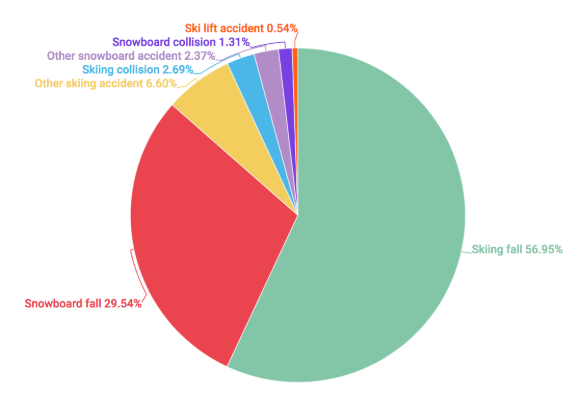Colorado provides a plethora of outdoor activities and adventure. What is very typical for a Coloradan, likely would be considered “extreme” by those elsewhere in the country.
Nearly all local skiers and snowboarders know to wear a helmet. (According to the data… about 80%). We all hear the news each year, early in the ski season, discussing the first ski deaths/injuries. Most often this is from head injuries. The 2017-2018 ski season resulted in 37 catastrophic injuries, including life-altering spine or head injuries. In 2017, there were 5,660 emergency room visits for ski or snowboarding accidents (About 100,000 since 2011). Of course, it should be known that ski resorts are not required to release lesser injuries.

Click image to enlarge
We all assume that those killed or severely injured are tourists or inexperienced skiers not wearing the proper protective gear. According to the National Ski Areas Associate report, however, the average death occurs in 30-year-old experienced male skiers, wearing a helmet, who hit a tree going too fast on an intermediate run. Beginners on green runs are very cautious. It’s the mixed-experienced people on blue runs where accidents most likely occur.
A possible contributing factor to head injuries is the misperception of the safety of helmets. Jerry Seinfeld once had a sadistically funny sketch on helmets in skydiving: “Why do they (skydivers) bother with the helmet…If you jump out of a plane 20,000 feet in the air and the chute doesn’t open, the helmet is now wearing you for protection… later on the helmet is talking to the other helmets saying ‘good thing he was there or I would have hit the ground directly’ ”.
This comedy bit is unfortunately true. In 2017, the Journal of Neurosurgery summarized the literature studying the efficacy of helmets against concussion and traumatic brain injury. In the helmet literature, there is clear effectiveness of helmets in lessening penetrating head injury, such as bullets. Helmets also seem to protect again skull fractures or hemorrhages. However helmets do not show significant reduction in concussion or mild traumatic brain injury. Due to this, considerable research is ongoing to improve helmet efficacy.
This information is not meant to dissuade anyone from wearing a helmet during activities. Your individual helmet use may prevent your injury or death. However, the statistics are a reminder that wearing a helmet does not obviate all risk, and should not promote a false sense of security.
Other, seemingly less risky, activities are also prone to head injuries and deserve caution (and helmet wearing).
Denver sidewalks are now commonly adorned with electronic scooters. Pay about $1 to start the thing, and you can ride one of these minimally regulated devices for about 15 cents per minute. There is no defined speed limit for scooters on sidewalks (although they usually cannot exceed 15 mph), and there is no helmet requirement over 18 years old.
JAMA Network Open recently published on the injuries caused by e-scooters. Only about 4% of injured riders wear helmets. About 5% have a blood alcohol level greater than 0.05%. 40% of injuries reported were head injuries.
A UCLA study found that 1 in 3 people involved in an e-scooter accident required an emergency room visit.
Bicycle, in-line skating and skateboarding are also common causes of head injury. In Denver, bicycle helmets are not required in those over 18 years old. Yet, head injuries account for more than 60% of bicycle-related deaths. In 2007 across the country, there were nearly 65,000 cycling induced head injuries seen in emergency rooms. This is compared to about 36,400 from football. Skateboarding contributed to about 16,500.
There’s a lot of fun to be had in Denver. However, safety and caution is critical.






